| کد مقاله | کد نشریه | سال انتشار | مقاله انگلیسی | نسخه تمام متن |
|---|---|---|---|---|
| 5737168 | 1614592 | 2017 | 9 صفحه PDF | دانلود رایگان |
- A preclinical testbed is demonstrated for embedding electrodes in artificial skull.
- Options are explored for increasing electrode surface area using the skull depth.
- Novel electrode designs could also be embedded in the bone directly via burr holes.
- The testbed's high contact density allows one to optimize electrode spacing.
- High density of contacts possible in artificial skull improves movement decoding
BackgroundCustom-fitted skull replacement pieces are often used after a head injury or surgery to replace damaged bone. Chronic brain recordings are beneficial after injury/surgery for monitoring brain health and seizure development. Embedding electrodes directly in these artificial skull replacement pieces would be a novel, low-risk way to perform chronic brain monitoring in these patients. Similarly, embedding electrodes directly in healthy skull would be a viable minimally-invasive option for many other neuroscience and neurotechnology applications requiring chronic brain recordings.New methodWe demonstrate a preclinical testbed that can be used for refining electrode designs embedded in artificial skull replacement pieces or for embedding directly into the skull itself. Options are explored to increase the surface area of the contacts without increasing recording contact diameter to maximize recording resolution.ResultsEmbedding electrodes in real or artificial skull allows one to lower electrode impedance without increasing the recording contact diameter by making use of conductive channels that extend into the skull. The higher density of small contacts embedded in the artificial skull in this testbed enables one to optimize electrode spacing for use in real bone.Comparison with existing methodsFor brain monitoring applications, skull-embedded electrodes fill a gap between electroencephalograms recorded on the scalp surface and the more invasive epidural or subdural electrode sheets.ConclusionsEmbedding electrodes into the skull or in skull replacement pieces may provide a safe, convenient, minimally-invasive alternative for chronic brain monitoring. The manufacturing methods described here will facilitate further testing of skull-embedded electrodes in animal models.
Journal: Journal of Neuroscience Methods - Volume 277, 1 February 2017, Pages 21-29
